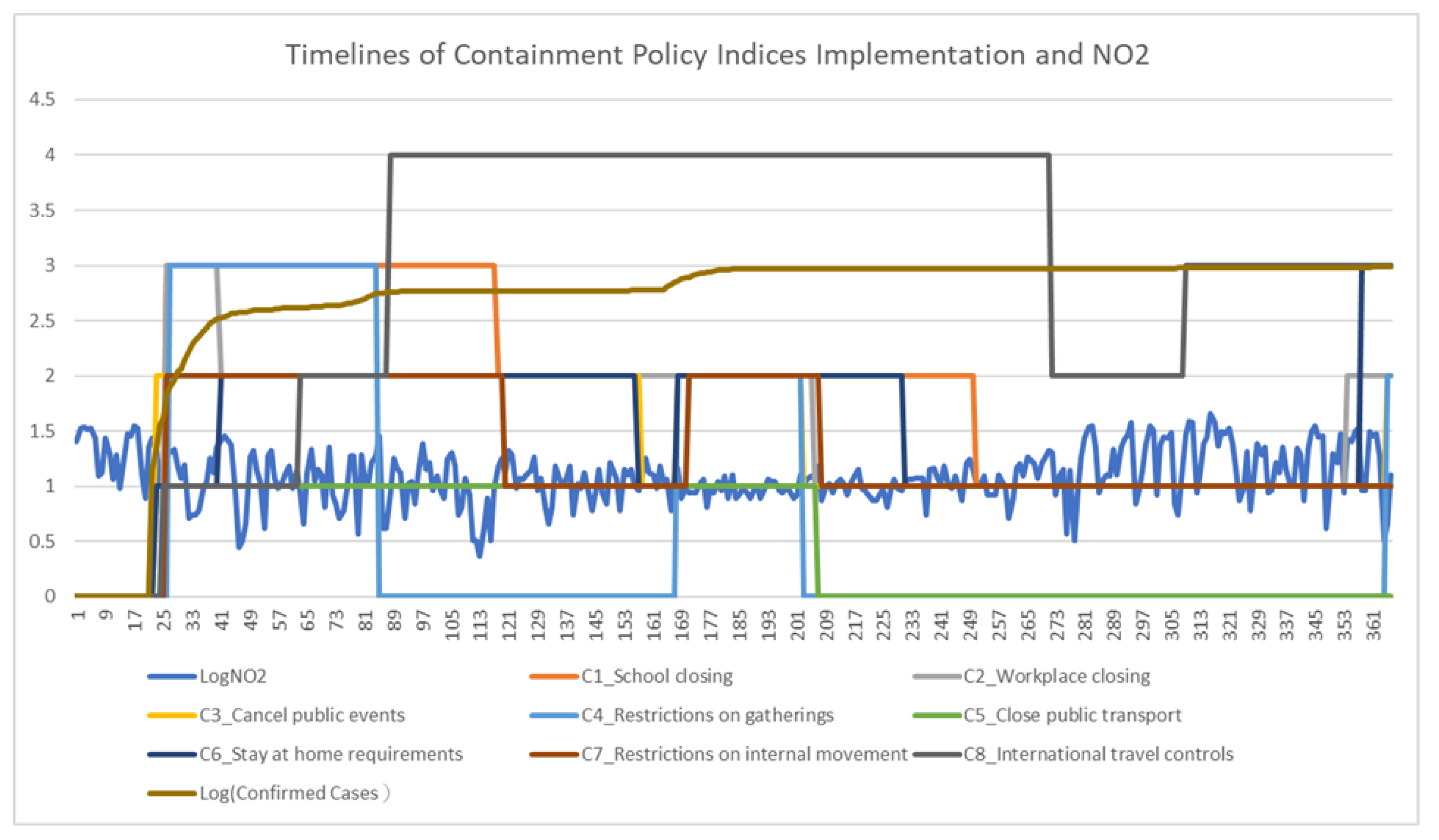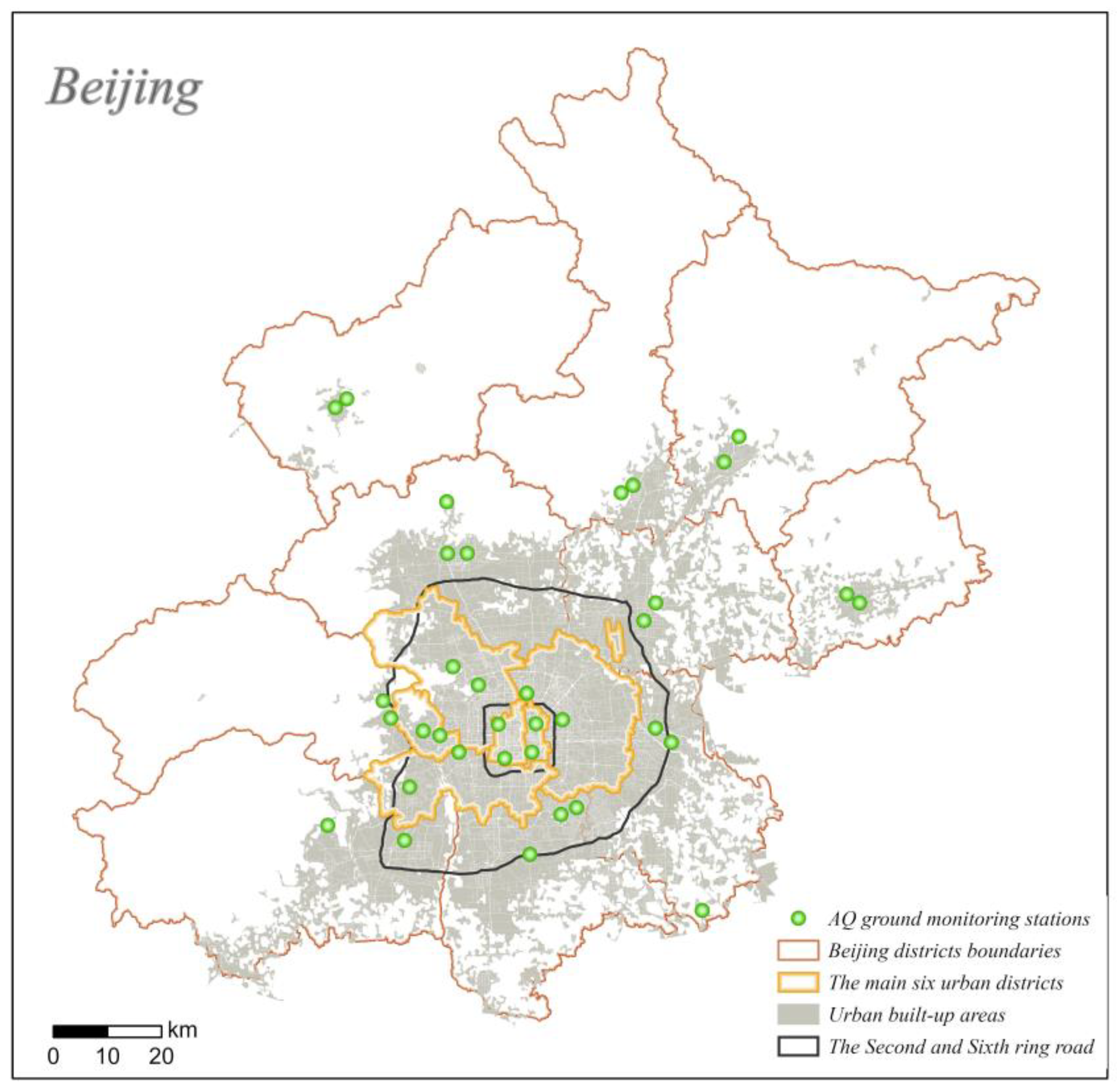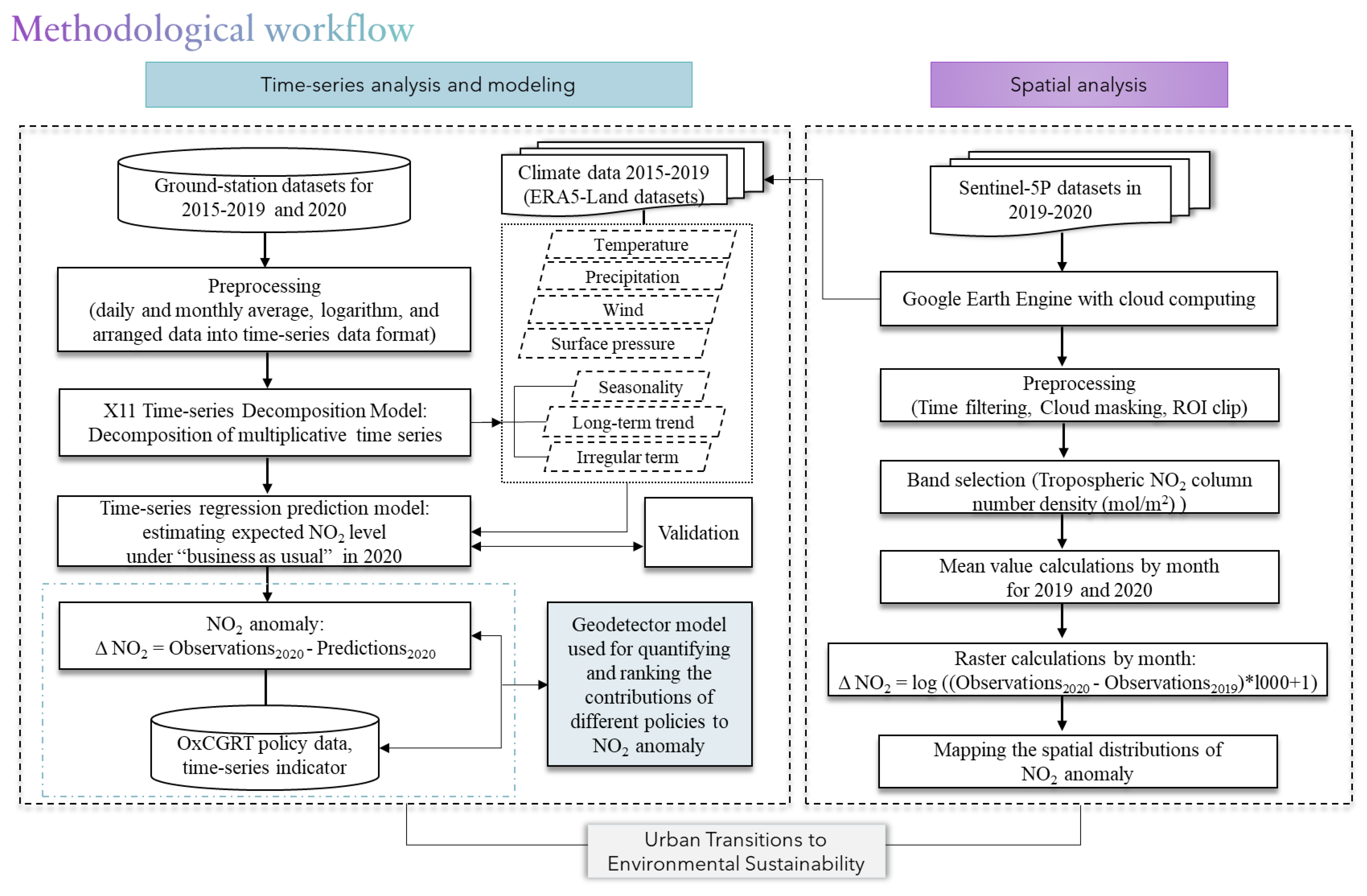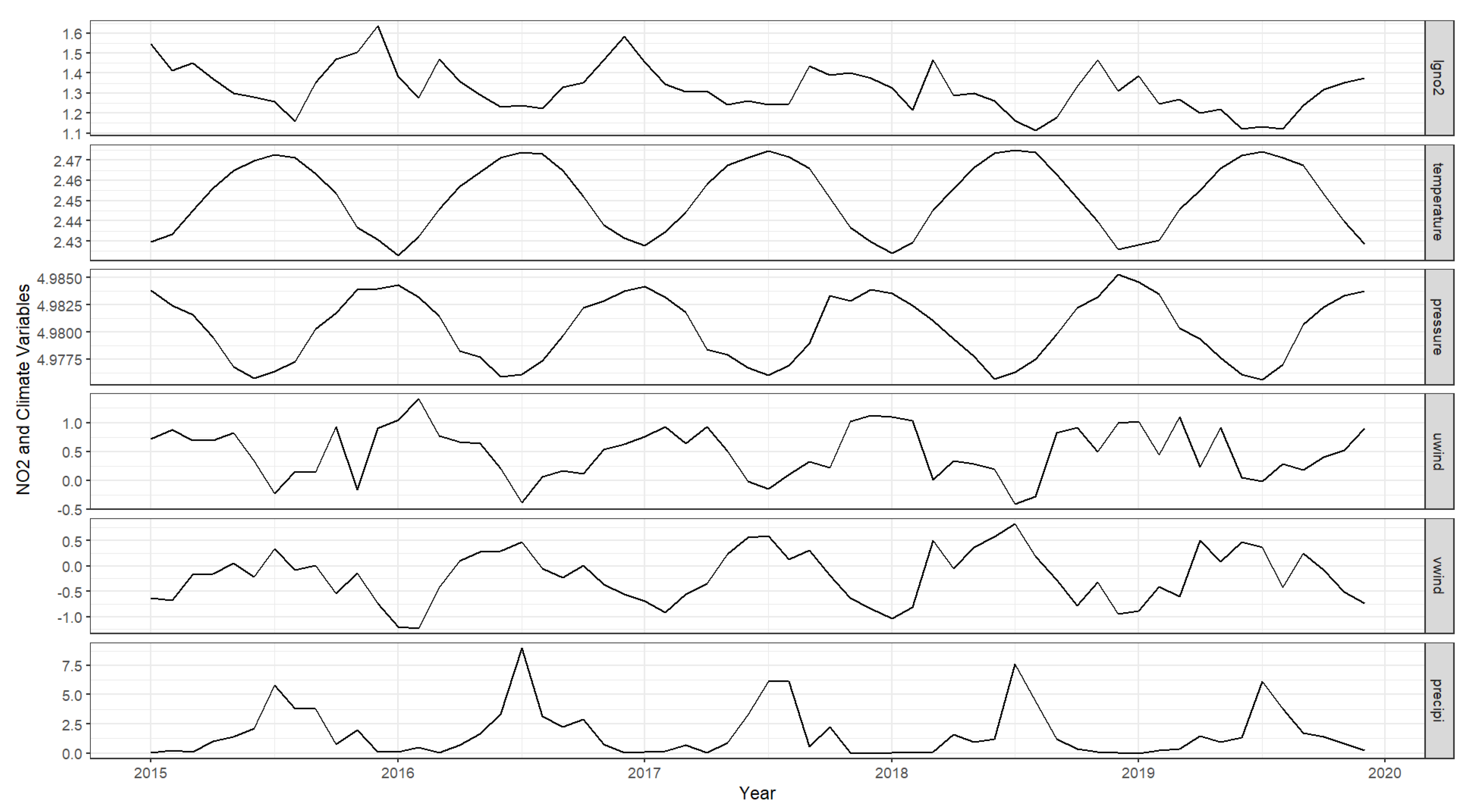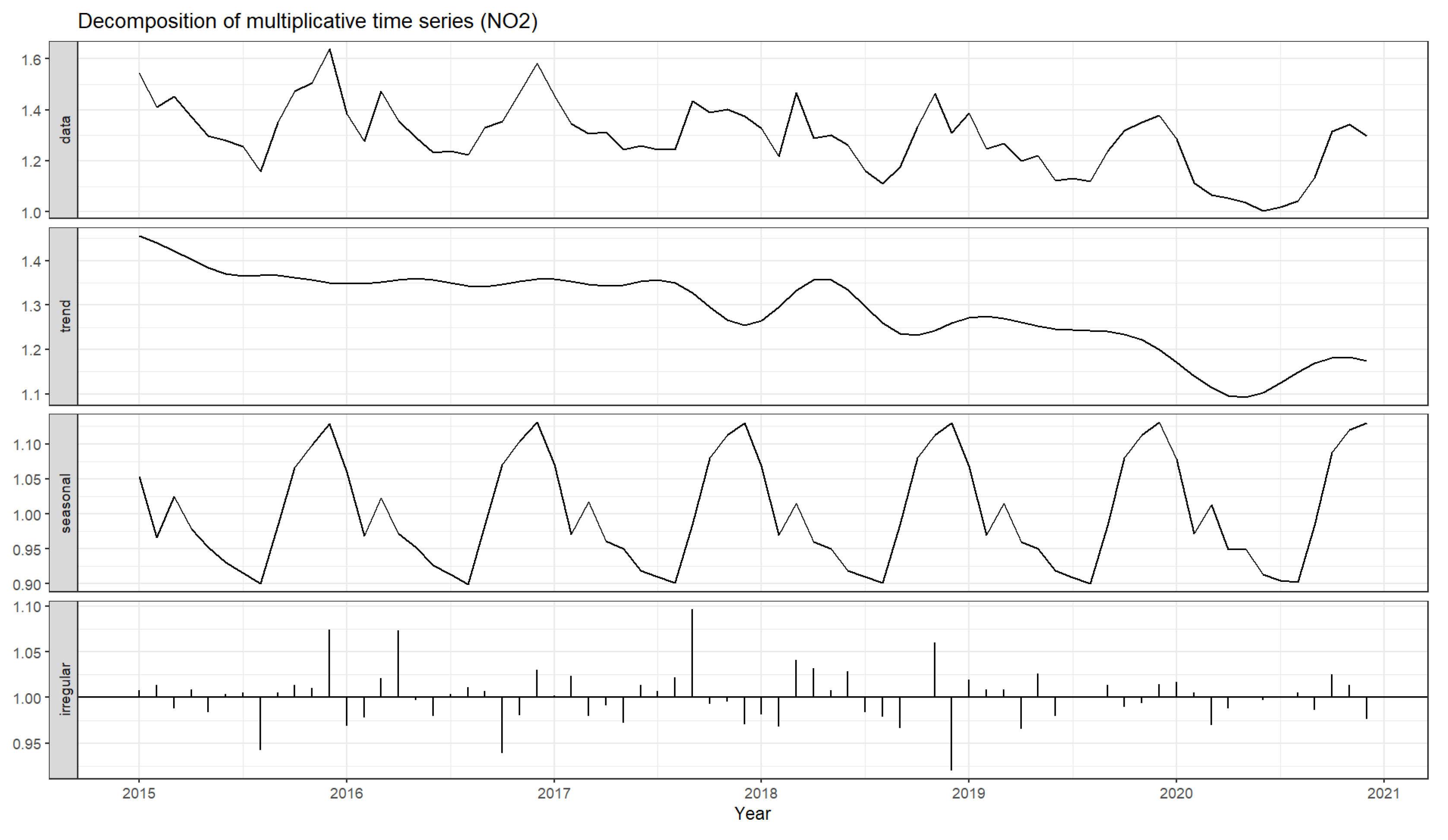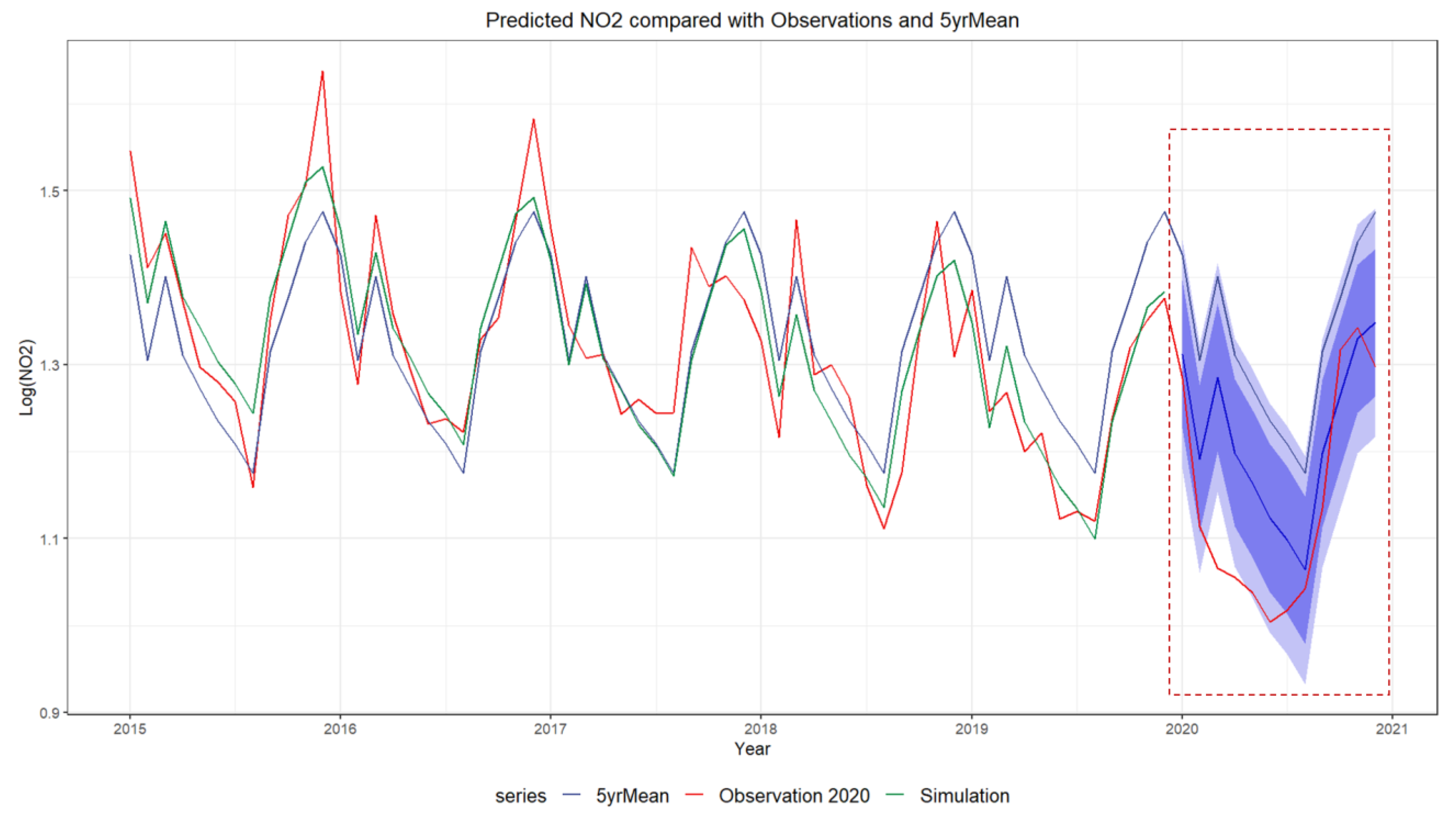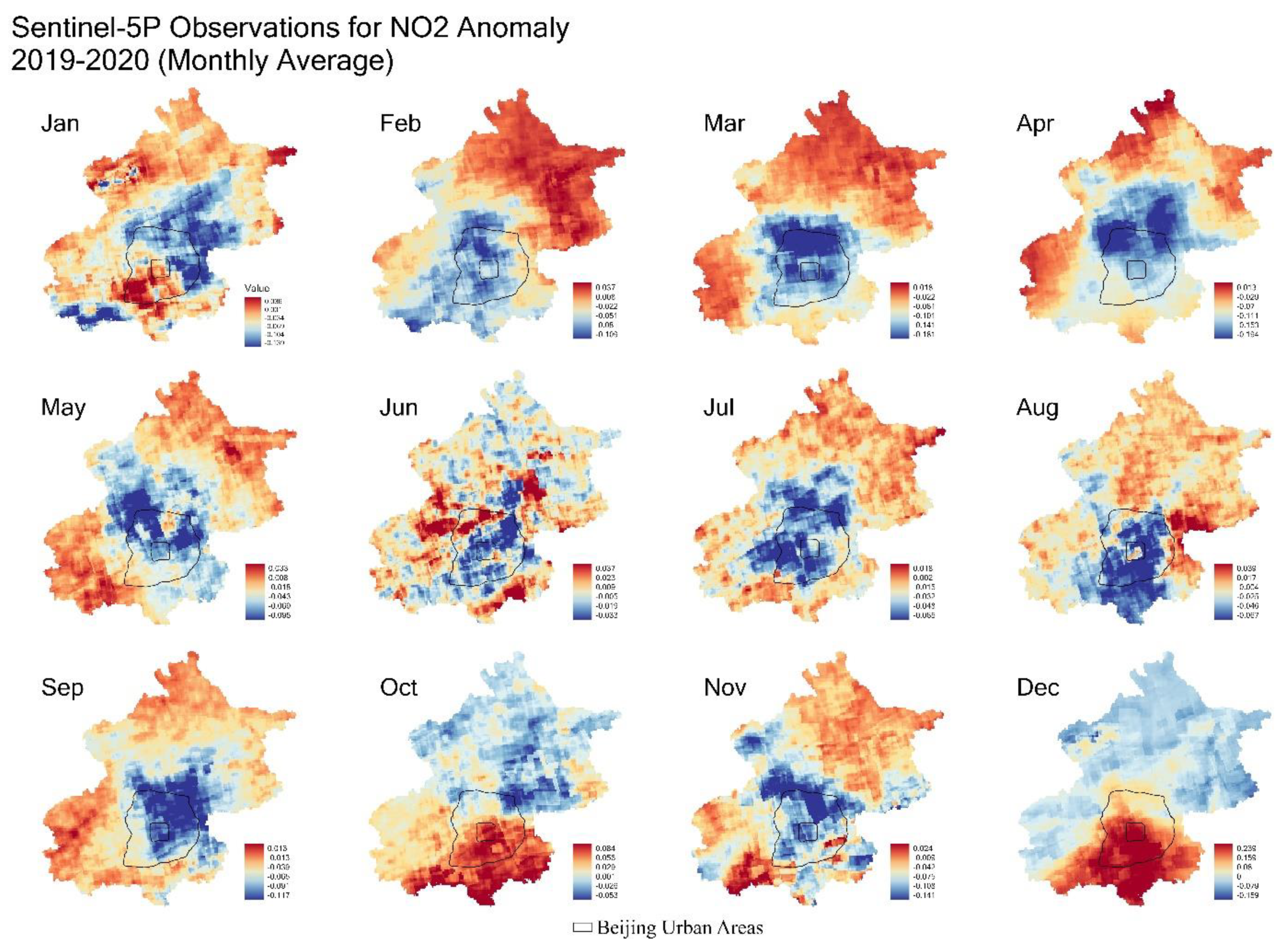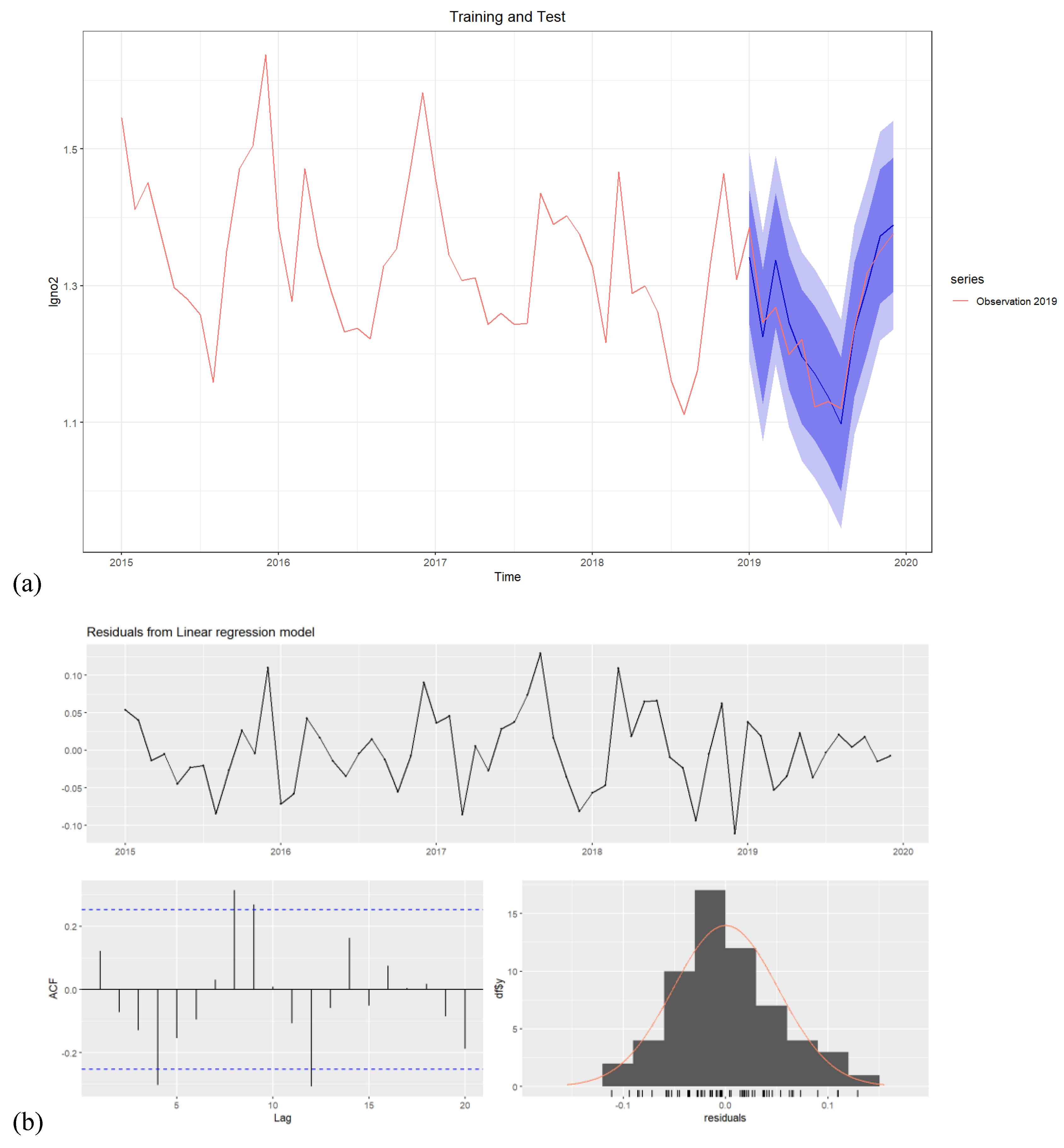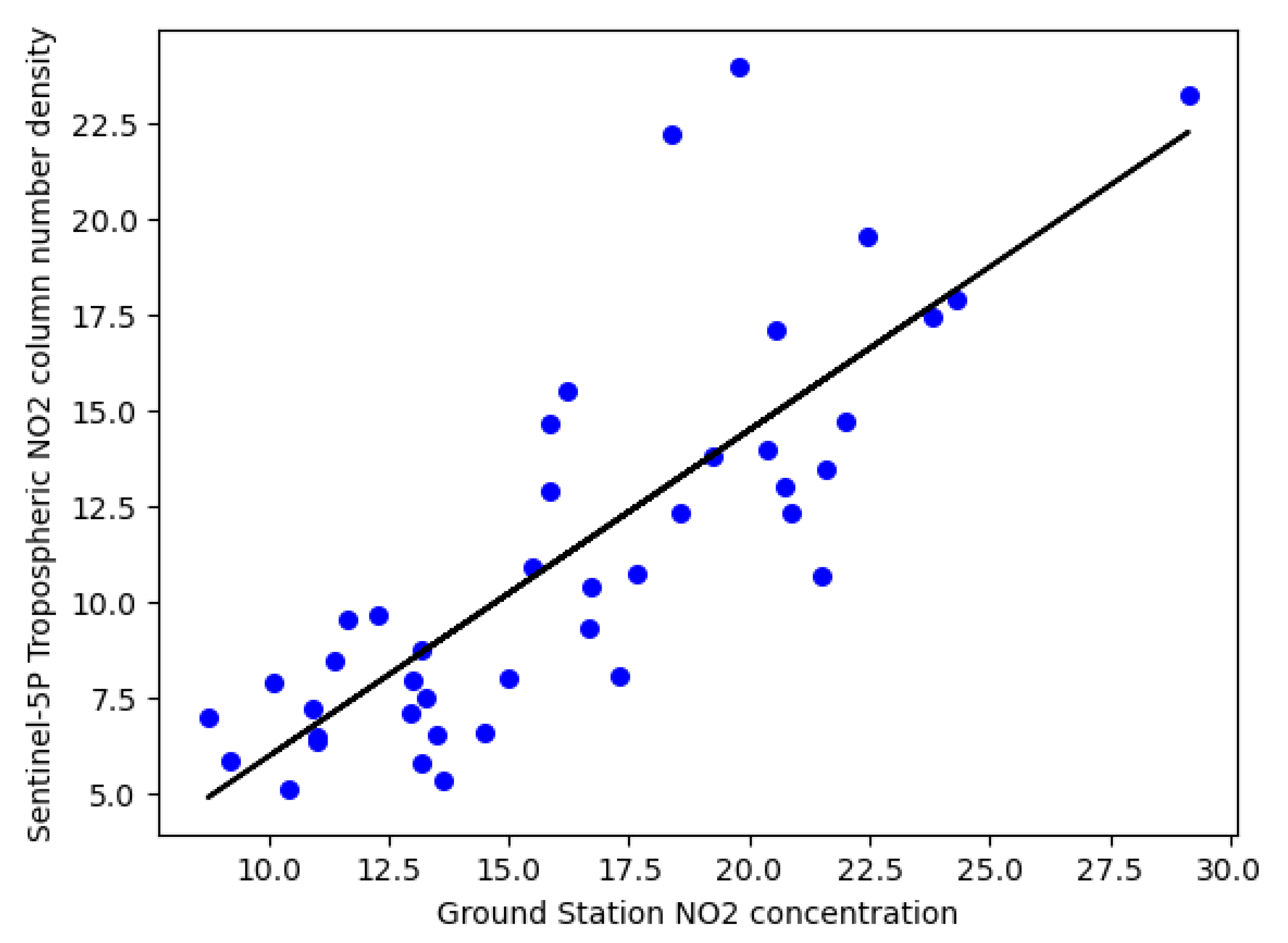1. Introduction
Nitrogen dioxide (NO
2) is a common air pollutant that can harm the environment and human health. The mainly anthropogenic NO
2 emissions was reported from the transport sector, industry, power, heating and residential sector [
1,
2]. Exposure to NO
2 has been linked to many respiratory diseases [
3]. Chronic exposure to NO
2 pollution led to a higher mortality rate during the COVID-19 pandemic [
4] and these pollutants affected virus transmission [
5]. Triggered by the pandemic, air pollution and traffic were identified as two of the top six environmental challenges facing cities [
6]. Unprecedented strong policy measures, as nonpharmaceutical interventions, were taken worldwide, especially in urban areas, restricting human activities and industrial production. The strict restrictions directly affected the emissions of various air polluting gases, and in turn, such changes in global and regional emissions may reflect the effects of different policies. In this context, a consensus has been proposed that this "pause button" created an unique window to assess anthropogenic effects on atmospheric composition and its relationship to human activities compared to “business as usual”. More importantly, it calls for extensive actions that can make full use of this “anomaly” opportunity to boost our cities shift to sustainability [
6], as sustainable development depends increasingly on the successful management of urban growth. NO
2 has been considered a good indicator of changes in local pollutant sources, as it has a shorter lifetime (within 1 day) compared with other air pollutants [
7]. Therefore, in this study, the sensitivity of NO
2 to policy responses during the COVID-19 pandemic can be captured or tracked by restriction measure changes on daily-scale. It provides an observational metric for examining the effects of diverse policy regulations on air pollution, reducing the complexity due to the hysteresis of some policy effects. It is important for understanding which policies (linked to different human activities) are effective in reducing emissions.
At the early stage of the epidemic, the observation-based concentrations of NO
2 pollutants were consistently reported to be below the levels of previous years, as a result of the sudden lockdowns and suspended human activities. Data from both satellite observations and ground-based monitoring stations found that global NO
2 concentrations were lower in 2020 than in 2019, especially in urban areas [
7,
8]. In Wuhan, China, the first reported outbreak city, the NO
2 in 2020 during lockdown was 42% lower than the average level of the previous three years [
9]. The reduction in transport sector emissions is reported as the main cause for global NO
2 anomalies [
8]. London experienced a 50% decrease in NO
2 during lockdown, with the highest NO
2 emission reductions observed during morning rush hours due to the radical changes in routine life and commuting time [
10]. Observations from other mega-cities, such as New York [
11], Tokyo [
12], Moscow [
7] and Toronto [
13], also showed a decrease in NO
2 concentrations during lockdowns. Nevertheless, some subsequent studies noted the possibility of exaggerating the positive effects of COVID-19 policies and pointed out that the improvement in air quality was not due to COVID-19 interventions but seasonal factors, as the lockdown period coincided with the onset of the rainy season in tropical regions, such as in Nigeria [
14] and Indonesia [
15]. This observation arises from the fact that most studies reported improvements in air quality based on comparisons between lockdowns and pre-lockdown periods or by taking the previous 3- to 5-year average level as the baseline. Some review papers investigated the nexus between the pandemic and the environment, showing that meteorological conditions affected NO
2 concentrations [
15,
16].
With continuous discussions on this popular topic and the accumulation of available multisource datasets, recent studies have begun to use the sensitivity changes of NO
2 to infer, correlate and retrieve various phenomena, consequences or environmental indicators related to it. In this context, ground-based instruments, alone or combined with satellite observations (e.g., from Ozone Monitoring Instrument (OMI) on-board Aqua satellite, Tropospheric Monitoring Instrument (TROPOMI) on-board Sentinel-5P), provide fundamental information about anthropogenic impacts. The stringency of policy indicators has been used for investigating certain impacts on the environment. Long-term temporal comparisons of tropospheric NO
2 vertical columns during the lockdown with the counterfactual baseline concentrations have been investigated with different extensions and specific perspectives. For example, Misra et al. [
17] retrieved the NO
2 concentration changes due to lockdown from OMI and TROPOMI and linked the changes to power plants over urban areas in northern India while considering the seasonal components of NO
2 and long-term trends over the same period in 2015-2019. Xing et al. [
5] used machine learning with multisource data to prove that reduced economic activity, inferred from NO
2 reductions (restrictions-induced), drove the slowdown in the number of COVID-19 infections in most regions [
5]. Highlighting that pollution has no borders, Li et al. [
18] clustered global continent grid cells, which were based on historical NO
2 pollution levels from OMI satellites for which seasonal trends had been removed, by subtracting 10-year daily mean values to investigate the impact of policy stringencies on different clusters (regions). There are significant differences between regions due to differences in measures taken, the duration of lockdowns, and the intensity of measures implemented by the government, which allows much potential for in-depth explorations.
Most of the existing studies documented the short-term positive effects of containment policy measures on declining air pollution; however, the long-term effects have not been fully considered, especially for other confounding factors, such as seasonality, climate conditions, air quality improvement trends and the local context. It may exaggerate the effects of covid-19 restrictions. Furthermore, few evidence-based methodologies could identify the effective policy which has direct impact on the NO2 anomaly and linked to specified human activities. In other words, very limited efforts have been made to differentiate and quantify the effects of different policies. This challenge may be a barrier for policy-makers or create indecision when effective actions are considered.
To fill the research gaps discussed above, in this study, we proposed that observations combined with predictions. We employed historical ground-station data combined with Sentinel-5P data to illustrate the sensitivities of NO2 concentrations to different policy measures of COVID-19. Particularly, we estimated the portion of NO2 anomalies caused by COVID-19 restriction policies by removing the confounding factors. The spatial and temporal variations of NO2 were visualized for interpretations based on remote sensing. Ultimately, this study applied spatial stratified heterogeneity statistics in time-series analysis; and by linking the daily-scale variations of containment measures to NO2 anomalies, we quantified and ranked the contributions of different policies. Such analysis is expected to generate a more reliable and accurate evaluation of the effects of different restriction policies on human activities that reflect on NO2 anomalies. It is essential to evaluate how policies can further guide human activities as cities transition to environmental sustainability during their post-epidemic recoveries. Furthermore, this evaluation may help shed light on some uncertainties regarding future global and regional climate responses to polluting gas emissions.
5. Validation
We evaluated the effectiveness of the model from each indicator shown in
Figure 7. In the process of model selection and calculation, we processed all data as time series data. First, we selected climate data (temperature, precipitation, wind and surface pressure) as the independent variables, as has been done for regression modelling for air pollution estimates in many studies. We simulated daily and monthly data, respectively, and found that the R
2 of monthly data (R
2 = 0.51) performed better than the daily data fitting results (R
2 = 0.34); however, the model fitting results were not good enough for our prediction goals. Combined with the X11 time series decomposition model, it was further found that the climate data itself exhibits certain seasonal components which are mainly of a cyclical nature, as can be seen from
Figure 3; this was especially evident with the monthly data. We therefore defined a trend term and seasonal dummy term for the multiple linear regression model in order to conduct the time-series prediction. The results showed that the monthly data fitting result has a better performance than previous experiments (R
2=0.80).
Since we used historical time-series data, the best way of validation is to use historical data 2015-2018 as training data for prediction, and to use 2019 observation data as verification (testing) data to compare that with the expected value from the model prediction results for 2019. The comparison results show that the overall accuracy reaches 97.71%.
Figure 7 shows the validation results, and it fits well.
Additionally, this study verified that the satellite data well comply with the ground data by applying a linear regression model. Although different instruments/sensors were used to observe NO
2 levels, the trend changes observed were relatively consistent and significantly correlated (R
2 = 0.65), as the
Figure 8 shown.
6. Conclusion and Discussion
In this study, we employed time-series decomposition and regression-prediction models to evaluate the effects of COVID-19 different containment policies on NO
2 anomalies in Beijing, China. Unlike most previous studies, we detected the effects from seasonality and a long-term downward trend on NO
2 changes and excluded them for analysis. This model design aimed to identify the specific effects due to lockdown measures. The combination of historical ground-based data with satellite datasets enables a more comprehensive evaluation of NO
2 anomalies than monitoring with a single source, by leveraging the strengths of both monitoring datasets. This study also verified a well-correlated relationship between these two measurements despite variations in resolutions and types, being consistent with previous studies [
25,
26].The results showed that observed changes exceeded expectations, with NO
2 decreasing by -6.08% on average every year, and as much as by -17.04% (95% CI, -7.71%~ -24.67%, p < 0.001) in March 2020 when the strictest lockdown measures were in place. Taking the 5-year average level as a baseline, our results show a reduction of 14.10% due to COVID-19 policy measures. Compared with existing research, it is significantly less than the 30%~40% reduction suggested in [
9,
11] at the city level; but the value is more close to the national average level by 6% [
5] though the spatial-temporal records has differences between national- and regional-scale. Therefore, our results suggested that the air quality policies and the local context should not be ignored when assessing the impacts of COVID-19 policies on changes in pollutant levels: beware of exaggerating the effects of the COVID-19 restrictions on NO
2 anomaly. Meanwhle, the combination of historical ground-based data with satellite datasets used in this study, enables a more comprehensive evaluation of NO2 anomalies than monitoring with a single source, by leveraging the strengths of both monitoring datasets. This study verified a well-correlated relationship between these two measurements despite variations in resolutions and types, being consistent with previous studies [
25,
26].
Beyond the effects of policies on NO
2 anomalies widely discussed in many studies [
7,
8,
18], the main novelty and contributions lied in that this study succeed to tell the difference of human activity containment and quantify their contributions to NO
2 anomalies. The top three measures showing dominant effects were C2 “Workplace closure”, C5 “Restricted public transport usage”, and C1 “School closure”, accounting for 54.8%, 52.3%, and 46.4%, respectively. These three dominant policies were respectively linked to restrictions on commuting activities, transportation, and education activities, which were likely to mitigate traffic congestion pressures in this city. By analyzing the contributions of different behavioral constraints to the NO
2 anomalies, we can speculate and reflect on the problems of urban structure and spatial development imbalance in Beijing, that is, the mismatch of employment and housing (determined by commuting patterns), educational inequality and the long-term unsolved congestions, as discussed in previous studies [
32,
33]. This convincing evidence influenced the top three corresponding restriction policies; in other words, promoting the transformation of urban spatial structure will effectively alleviate air pollution. Now we have the chance to boost the urban shift to environmental sustainability goals, as cities have become more flexible and open to change than in the past in regard to urban planning and environmental management for post-pandemic recovery.
Information about factors which reduce NO2 emissions during COVID-19 can be helpful in designing policy responses. As seen in this study, the restrictions on human activities, especially those related to transport, played a dominant role in the observed reduction of NO2. By removing seasonal and trend impacts, the study revealed that NO2 levels rebounded in the second half of 2020, especially in October and November, with peaks appearing in November that were earlier than in previous years (higher than expected according to the natural cycle). This suggests that the government’s recovery policies, for example to stimulate production activities, should also take into consideration the “retaliatory” emissions. This study is expected to help decision-makers to identify the effects and sensitivity of NO2 to different policy responses, thereby allowing them to make more precise policies which balance air pollution control and measures to support post-COVID-19 recovery. We have identified the dominant policies and assessed their corresponding magnitudes of influence at the urban-scale level. This evidence may help other regions to examine the impact of their own policies.
This study focuses on evaluating the effects of pandemic restrictions on NO2 anomalies, it also has some limitations. One is that the forecast of atmospheric trace gases is a complex task which requires expert knowledge in atmospheric sciences. This calls for greater cooperation between researchers in different fields in future. Furthermore, the study used monthly average data to detect NO2 anomalies during COVID-19 and the model results were well-fitted, while the analysis and simulations for daily changes in NO2 requires more complex models which can handle a 5-year time scale or even longer, as well as the effects of emerging events, climate change and other uncertainties. Some less obvious potential sources of pollution should also be given more attention. For example, telecommuting decentralized office activities and reduced travel activities, but stay-at-home orders are likely to have increased household consumption of energy. Another consideration is whether less usage of public transport will increase the demand for private cars and generate more pressure on air quality. Next, comparison studies between countries will be conducted to explore different policy-driven forces, and the applications of these methodology may further examine the variability over regions and time. It would also be useful to fine-tune these methods to assess the policy sensitivity of other types of air pollutants.
The combination of historical ground-based data with satellite datasets enables a more comprehensive evaluation of NO
2 anomalies than monitoring with a single source, by leveraging the strengths of both monitoring datasets. Ground station monitoring offers more accurate in localized measurements of NO
2 concentrations, but it is limited in its coverage of broader geographic areas. Conversely, satellite monitoring has the capability to cover larger areas, reflecting heterogeneity in spatial distribution but it has a relatively less precise localized monitoring. By a more thorough evaluation of NO
2 anomalies was evaluated, in particular, interpreting the relationship to various policy-induced restrictions and their impact on urban structure. This is supported by previous studies [
25,
26] as well as the validation of this study, which shows that these two measurements have a well-correlated relationship despite variations in resolutions and types.
Figure 1.
Map of study area, overlay with Air Quality (AQ) ground-station distributions (as the green points). The built-up areas come from [
24] represent the urban extent in general; The ring roads witnessed the development and expansion of the city that can help with understanding the urban, suburban, and rural areas of the city. In particular, the areas within the second ring road are the historic urban centers, the sixth ring road is currently the outermost ring road.
Figure 1.
Map of study area, overlay with Air Quality (AQ) ground-station distributions (as the green points). The built-up areas come from [
24] represent the urban extent in general; The ring roads witnessed the development and expansion of the city that can help with understanding the urban, suburban, and rural areas of the city. In particular, the areas within the second ring road are the historic urban centers, the sixth ring road is currently the outermost ring road.
Figure 2.
Overview of the methodological workflow.
Figure 2.
Overview of the methodological workflow.
Figure 3.
Initial analysis graph based on characteristics of monthly average of NO2 emissions from 2015 to 2019 and meteorological factors (temperature, precipitation, wind, surface pressure) in Beijing China. lgno2 represents the logarithm of NO2, uwind represents Eastward component of the 10m wind, vwind represents Northward component of the 10m wind, precipi represents precipitation here.
Figure 3.
Initial analysis graph based on characteristics of monthly average of NO2 emissions from 2015 to 2019 and meteorological factors (temperature, precipitation, wind, surface pressure) in Beijing China. lgno2 represents the logarithm of NO2, uwind represents Eastward component of the 10m wind, vwind represents Northward component of the 10m wind, precipi represents precipitation here.
Figure 4.
Decomposition of multiplicative time series of observed NO2 data from 2015 to 2020 based on ground station data. The top graph is the original observed NO2 data, consisting of the trend, seasonal and irregular components (the three-bottom terms).
Figure 4.
Decomposition of multiplicative time series of observed NO2 data from 2015 to 2020 based on ground station data. The top graph is the original observed NO2 data, consisting of the trend, seasonal and irregular components (the three-bottom terms).
Figure 5.
Comparison between observation and expectation (prediction line). The multiple linear regression model prediction line (blue line with buffer range) is shown as the base map (the light blue buffer is the 95% confidence interval), superimposing on the previous 5-year average as the reference baseline (grey blue line namely 5yrMean as shown) and the regression simulation fitting curve (light grey line), compared to the actual observed value (red line).
Figure 5.
Comparison between observation and expectation (prediction line). The multiple linear regression model prediction line (blue line with buffer range) is shown as the base map (the light blue buffer is the 95% confidence interval), superimposing on the previous 5-year average as the reference baseline (grey blue line namely 5yrMean as shown) and the regression simulation fitting curve (light grey line), compared to the actual observed value (red line).
Figure 6.
Changes of NO2 levels comparing the years 2019 and 2020, using the monthly average data of tropospheric NO2 column number density (mol/m2) from Sentinel 5P. The changes or differences are calculated by taking 2020 levels minus the same period in 2019. The satellite observation data show the spatial heterogeneity (different spatial distributions) of NO2 levels at 1 km spatial resolution.
Figure 6.
Changes of NO2 levels comparing the years 2019 and 2020, using the monthly average data of tropospheric NO2 column number density (mol/m2) from Sentinel 5P. The changes or differences are calculated by taking 2020 levels minus the same period in 2019. The satellite observation data show the spatial heterogeneity (different spatial distributions) of NO2 levels at 1 km spatial resolution.
Figure 7.
Model performance assessment results and the residuals analysis of the time-series multi-linear regression prediction model. (a) shows the validation results in terms of using the data for 2015-2018 for training and the 2019 observation data for comparison. (b) shows a time plot, the ACF and the histogram of the residuals from the multiple regression model fitted to the NO2 data, as well as the Breusch-Godfrey test for jointly testing up to 16th order autocorrelation. The histogram shows that the residuals seem to be slightly skewed, which may also reflect the coverage probability of the prediction intervals.
Figure 7.
Model performance assessment results and the residuals analysis of the time-series multi-linear regression prediction model. (a) shows the validation results in terms of using the data for 2015-2018 for training and the 2019 observation data for comparison. (b) shows a time plot, the ACF and the histogram of the residuals from the multiple regression model fitted to the NO2 data, as well as the Breusch-Godfrey test for jointly testing up to 16th order autocorrelation. The histogram shows that the residuals seem to be slightly skewed, which may also reflect the coverage probability of the prediction intervals.
Figure 8.
The correlation between the ground station NO2 concentration and Satellite observed tropospheric NO2 column number density. The analysis was based on 42 monthly average data from July 2018 to December 2021 as the NO2 column was released by Sentinel 5P since July 2018.
Figure 8.
The correlation between the ground station NO2 concentration and Satellite observed tropospheric NO2 column number density. The analysis was based on 42 monthly average data from July 2018 to December 2021 as the NO2 column was released by Sentinel 5P since July 2018.
Table 1.
Comparison of results between observation and expected trend.
Table 1.
Comparison of results between observation and expected trend.
| Month |
Predicted 2020 (95% CI) |
Observ 2019 |
5-yr baseline |
Observ
2020 |
Predicted 2020- Observ 2019 |
Observation -Prediction 2020 |
Observation
2020-2019 |
Observation-5yr-baseline |
| Jan |
1.312±0.13 |
1.385 |
1.426 |
1.285 |
-5.32% |
-2.07% |
-7.25% |
-9.93% |
| Feb |
1.192±0.13 |
1.247 |
1.305 |
1.114 |
-4.42% |
-6.52% |
-10.63% |
-14.65% |
| Mar |
1.285±0.13 |
1.268 |
1.401 |
1.066 |
1.32% |
-17.04% |
-15.95% |
-23.92% |
| Apr |
1.198±0.13 |
1.200 |
1.310 |
1.056 |
-0.10% |
-11.92% |
-11.97% |
-19.45% |
| May |
1.163±0.13 |
1.221 |
1.272 |
1.038 |
-4.79% |
-10.78% |
-15.01% |
-18.42% |
| Jun |
1.124±0.13 |
1.123 |
1.235 |
1.004 |
0.07% |
-10.61% |
-10.58% |
-18.67% |
| Jul |
1.098±0.13 |
1.131 |
1.209 |
1.018 |
-2.88% |
-7.33% |
-9.98% |
-15.81% |
| Aug |
1.064±0.13 |
1.120 |
1.175 |
1.043 |
-5.05% |
-1.99% |
-6.91% |
-11.26% |
| Sep |
1.198±0.13 |
1.238 |
1.315 |
1.135 |
-3.23% |
-5.30% |
-8.32% |
-13.73% |
| Oct |
1.266±0.13 |
1.320 |
1.377 |
1.317 |
-4.10% |
+4.05% |
-0.19% |
-4.36% |
| Nov |
1.330±0.13 |
1.351 |
1.441 |
1.342 |
-1.56% |
+0.94% |
-0.66% |
-6.84% |
| Dec |
1.348±0.13 |
1.376 |
1.476 |
1.297 |
-2.05% |
-3.82% |
-5.77% |
-12.13% |
| Average Reduced by |
-2.68% |
-6.03% |
-8.60% |
-14.10% |
Table 2.
q-statistics of different policy factors.
Table 2.
q-statistics of different policy factors.
| Containment |
q |
p value |
Policy intensity (Sig t test:0.05) |
| Policy measures |
0 |
1 |
2 |
3 |
4 |
| C1 School closing |
0.464 |
0.000 |
0.028 |
0.010 |
0.087# |
0.131 |
-- |
| C2 Workplace closing |
0.548 |
0.000 |
0.028 |
0.015 |
0.122# |
0.051 |
-- |
| C3 Cancel public events |
0.448 |
0.000 |
0.028 |
0.025 |
0.119#
|
-- |
-- |
| C4 Restrictions on gatherings |
0.148 |
0.000 |
0.054 |
0.091 |
0.127# |
-- |
-- |
| C5 Close public transport |
0.523 |
0.000 |
0.018 |
0.120# |
-- |
-- |
-- |
| C6 Stay at home requirements |
0.421 |
0.000 |
0.028 |
0.023 |
0.116# |
0.044 |
-- |
| C7 Restrictions on internal movement |
0.289 |
0.000 |
0.028 |
0.043 |
0.120# |
-- |
-- |
| C8 International travel controls |
0.153 |
0.000 |
0.028 |
0.072 |
0.063 |
0.020 |
0.092# |
